Persimmon Pulp Recipe
Persimmon pulp is useful stuff. It’s great for baking, parfaits, and all sorts of desserts.
While I do want to share this recipe for persimmon pulp with you here, I think I should also cover some persimmon basics for those who don’t know.
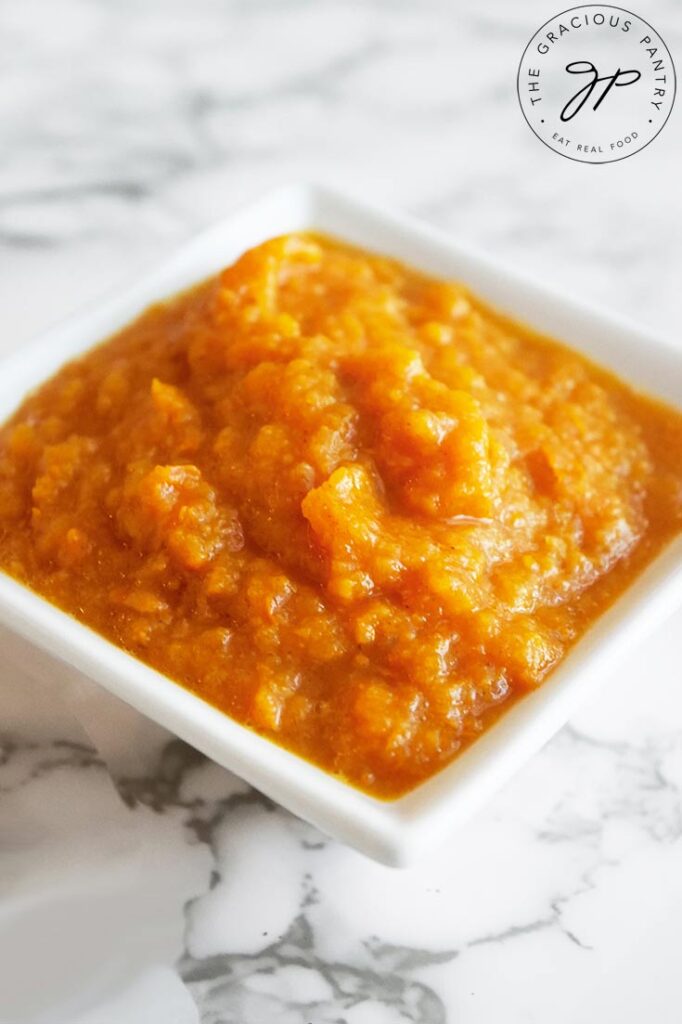
It’s amazing to me that so few people around me have had persimmons. Some of my neighbors didn’t even know what they were! So here’s a quick “persimmon 101” lesson for you. Then I’ll move on to the recipe.
There are two types of persimmons, Fuyu and Hachiya. They are loaded with good-for-you nutrients and are great for bolstering your immune system during the colder months. They have been used to treat everything from hiccups to cancer as a natural remedy and are even credited with phytochemicals that help prevent aging. How’s that for a super fruit?!
Hachiya Persimmons
Pictured below. These are longer “acorn-shaped” persimmons that you eat when very soft. Eating them while they are still even slightly hard is a very unpleasant experience, to say the least. (Not that I know from personal experience or anything… ahem…). Please allow your Hachiyas to sit on your windowsill until they are so soft you would swear they are rotten. You should be able to compare them to a rotten tomato. Soft, soft, soft!
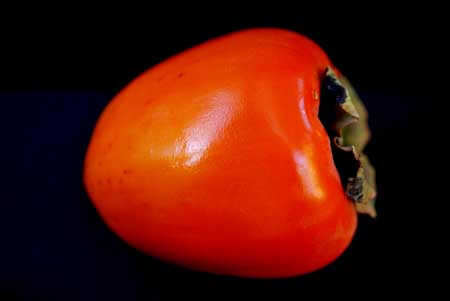
Fuyu Persimmons
Shown below. These look similar to tomatoes, but they are treated just like an apple. Peel, slice and eat.
Just like apples, you can cook them and turn them into an “apple-sauce” like pulp, which can be added or turned into just about any recipe. These are the persimmons I have on hand, so these are the persimmons used in the following recipe.
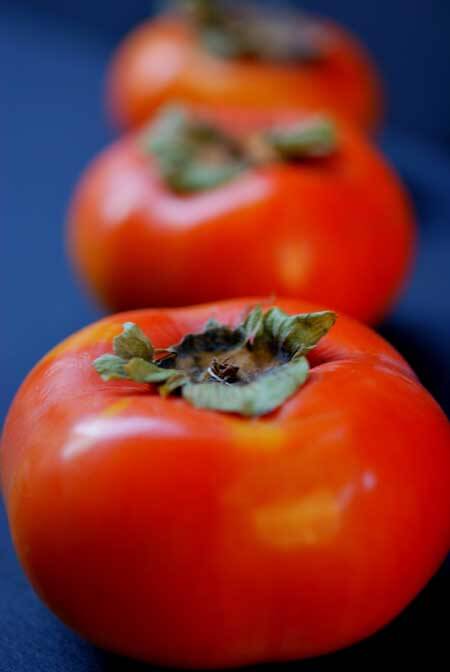
Persimmon pulp is nothing but persimmons, some water, and a little cinnamon. But I thought a “how-to” might be in order. So here’s the process.
About The Ingredients
Fuyu persimmons – These are flat, apple-shaped persimmons.
Ground cinnamon – This is optional, but it adds a nice flavor.
Water – You might not need all of this. You don’t want to fully cover the persimmons, so if you don’t need it all, don’t use it all.
How To Make Persimmon Pulp
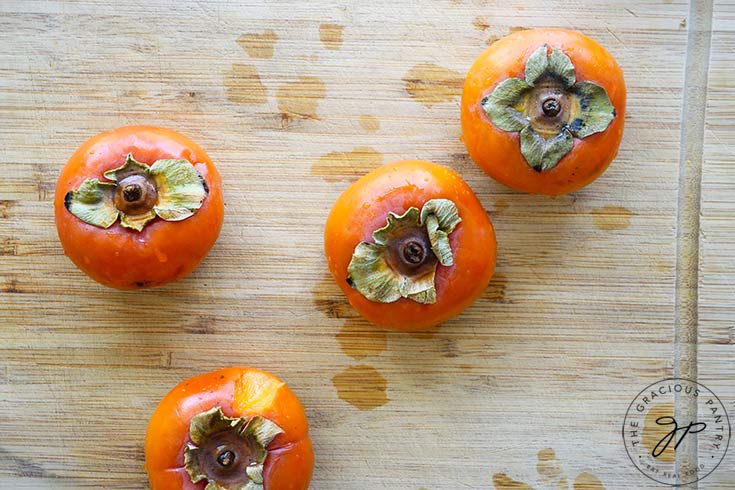
I used Fuyu persimmons for this. If you prefer to use Hachiyas, let them get super soft and scoop the flesh out of the skin. Then mash with a fork if needed. You do not need to cook Hachiyas to make persimmon pulp.
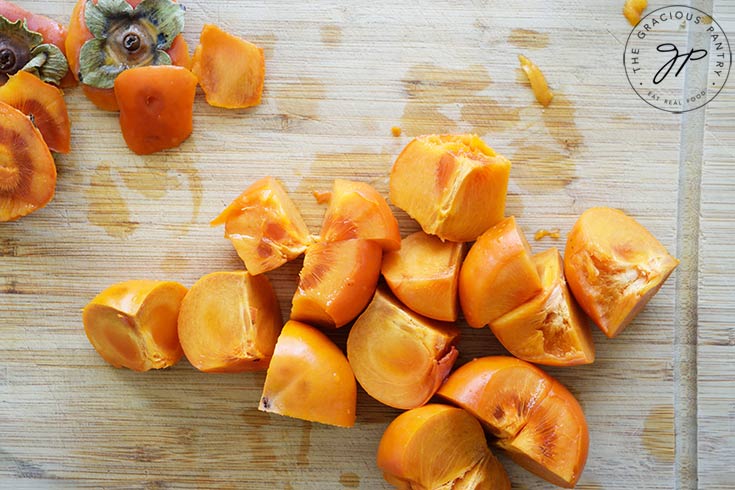
Wash, de-stem, and cut the persimmons into quarters.
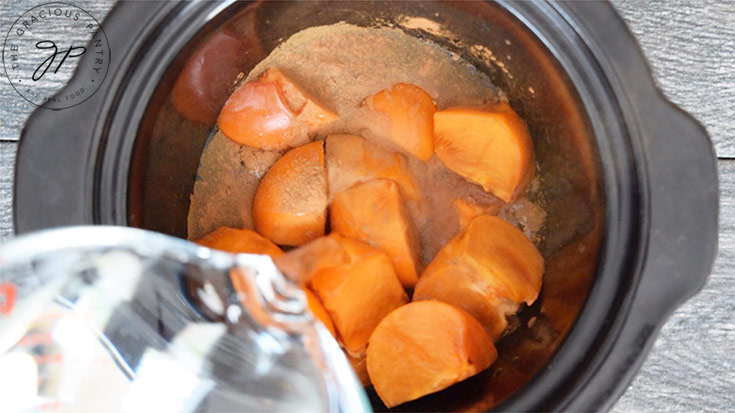
Put the persimmons, water and cinnamon in a slow cooker.
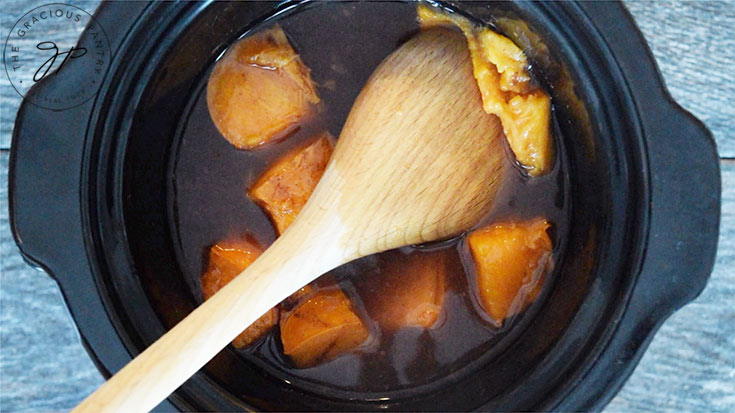
Cover with a lid and cook for approximately 4 to 6 hours. You know they are done with you can squish a piece against the side of the slow cooker without too much resistance.
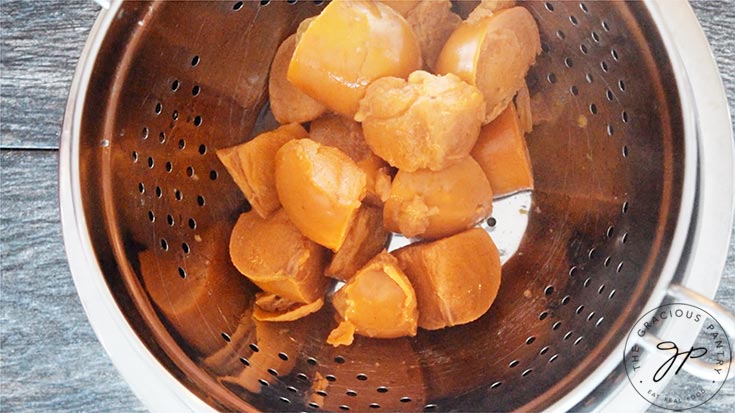
Now you have three options. You can transfer the persimmons to a colander set over a pot or bowl to catch the pulp. (You can discard any water left behind in the slow cooker, but use about a ¼ cup when mashing or blending. Just enough for an apples sauce consistency.)
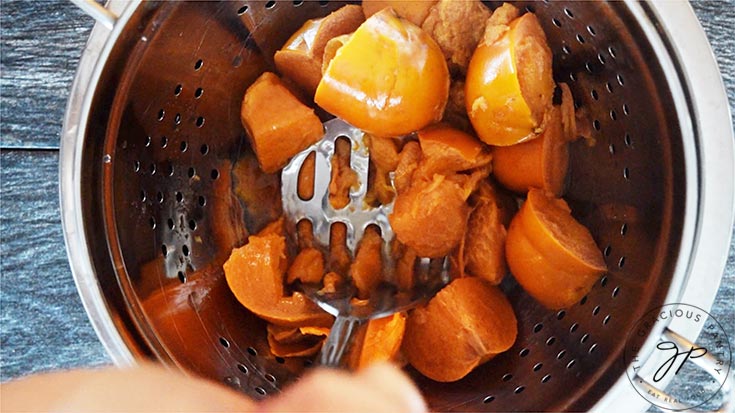
Start mashing them.
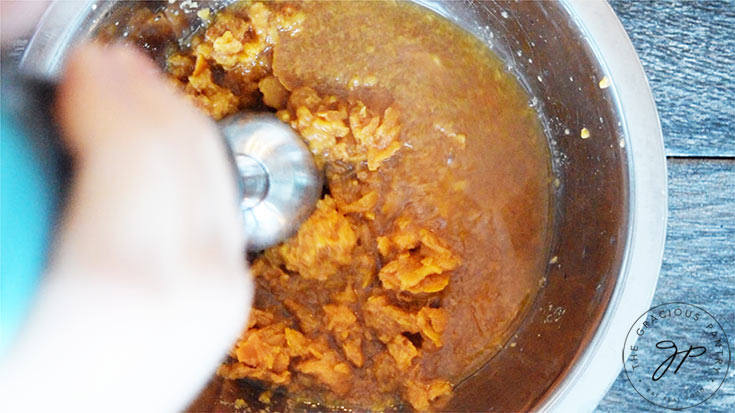
If you find that you are not getting enough pulp to come out (this can happen, it’s not a big deal), simply transfer the persimmons and a small amount of their cooking water to a food processor, or use a hand blender directly in the bowl.
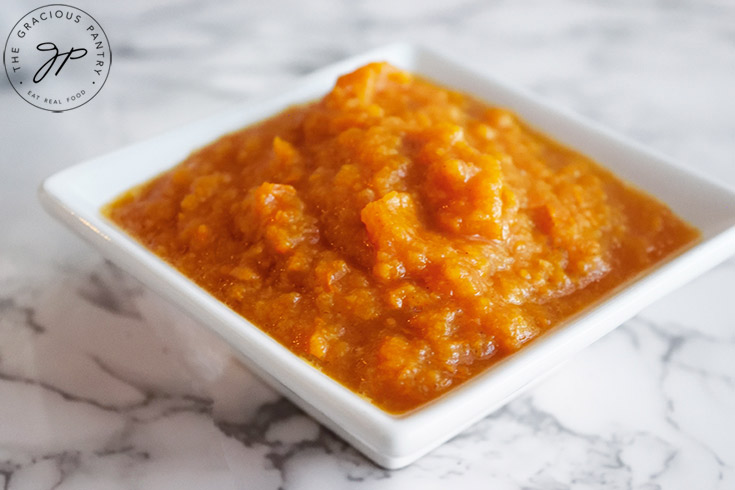
Blend in pulses until you have the consistency of apple sauce. Store in the fridge for up to 4 days or freeze for up to 6 months.
How To Store Persimmon Pulp
Keep this in an airtight container and store it in the fridge for up to 4 days.
Freezing Persimmon Pulp
This freezes very well. Make sure it’s packed well in an airtight container or freezer-safe bag, and store it in the freezer for up to 6 months.
More Persimmon Recipes
Persimmon Pulp Recipe Card

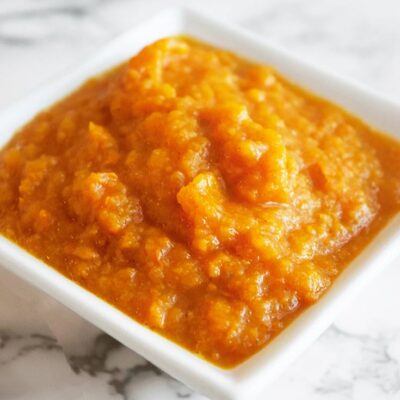
Persimmon Pulp
CLICK TO WATCH THIS RECIPE IN ACTION!
Equipment
- Slow Cooker
- Colander OR hand blender OR food processor
Ingredients
- 4 medium Fuyu persimmons
- 1 tsp. ground cinnamon
- 2 cups water (or less. You don't want to fully cover the persimmons, so if you don't need it all, don't use it all.)
Instructions
- Wash, de-stem and cut the persimmons into quarters.

- Put the persimmons, water and cinnamon in a slow cooker.

- Cover with a lid and cook for approximately 4 to 6 hours. You know they are done with you can squish a piece against the side of the slow cooker without too much resistance.

- Now you have three options. You can transfer the persimmons to a colander set over a pot or bowl to catch the pulp. (You can discard any water left behind in the slow cooker, but use about a ¼ cup when mashing or blending. Just enough for an apples sauce consistency.)

- Start mashing them.

- If you find that you are not getting enough pulp to come out (this can happen, it's not a big deal), simply transfer the persimmons and a small amount of their cooking water to a food processor, or use a hand blender directly in the bowl.

- Blend in pulses until you have the consistency of apple sauce. Store in the fridge up to 4 days or freeze up to 6 months.



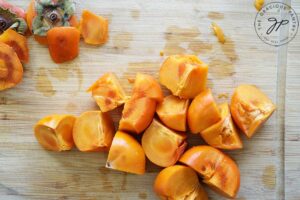
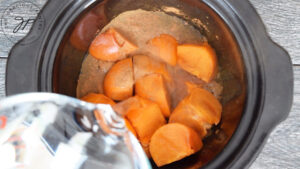
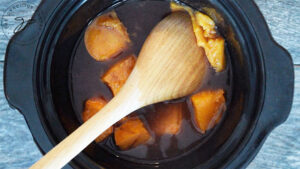
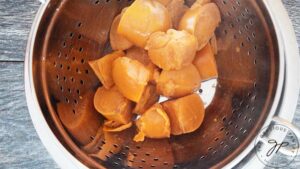
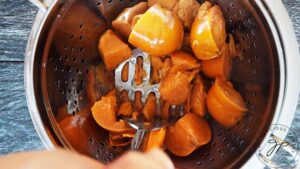
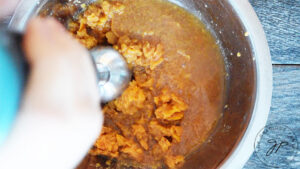
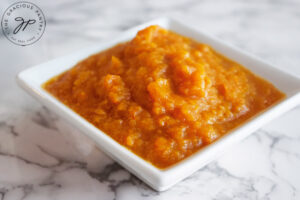
You don’t indicate how much/many persimmon you use for the pulp … one or twelve or?????
Kae – I updated the recipe. It’s a loose measurement. I was using my crock pot and I used enough to fill up the pot.
Looks like a wickedly easy process. When you say to “clean” the fruit, do you also mean topeel them? Or will a simple rinse and wipe do?
Folly – A simple rinse and wipe is all you need! Enjoy!
Tina – No, you want the sieve. It’s a bit more work, but it separates out all the stuff you don’t want.
Looks so yummy can not wait to try it
Sure, just email the recipe. I’d love to see it. Thanks!
Any chance we an use our juicer to get the pulp?
No, it won’t do the same thing. Sorry!
Good Morning,
I tried the persimmon pulp recipe using the crockpot adding water and cinnamon with high hopes. However, the result was disappointing, and I ended up throwing the persimmons away. The cinnamon took away the persimmon taste and the result was similar to the astringent taste resulting from eating a not ripe persimmon. Also and more importantly, trying to separate the persimmon pulp from the seeds/skin/stem using a strainer was impossible without using a spoon to individually separate each seed from the cooked goo.
I will revert to my time consuming process of removing the seeds from each persimmon then pressing out the pulp using a hand food mill.
Thanks and good luck with your business!
Lonnie B
Lonnie – What type of persimmons did you use? Something definitely went wrong there. Mine was not even close to what you describe here.
I am puzzled about the seed part. The persimmon I used tonight have no seeds. I just peeled them, took the harder core out, cut them up in little pieces and used them in my “pudding” recipe. It was very easy and yummy.
Catherine – If yours didn’t have any seeds, then not to worry. Sounds like it worked just fine! 🙂
The same thing happened to me—they tasted sweet and ripe raw, but separated and went horribly astringent in the slow cooker. I used hachiyas. I have no idea why that would have happened!
Jenn – Hmmm. I’m so sorry that happened. Let me see if I can figure out what’s happening.
sounds like Lonnie used the native persimmon to North America. they are about the size of quarters and full of dime sized seeds. your picture indicates you are using some of the asian persimmons that are tennis ball sized and no seeds.
Debbie – Thanks! 🙂
I was recently introduced to the Asian persimmon by a co worker. Instant addiction. I simply wash it and eat everything but the hardened bloom on top of them.
Beverly – That’s awesome! 🙂
I am in South Korea and recently a student gave me a BUNCH of persimmons. They have seeds and are delicious, but I would like to make some pulp. I unfortunately do not have a slowcooker, but rather a pressure cooker and a regular saucepan. As I am in a small South Korean apartment, I also have no oven, just two burners. Can i make this pulp in my pressure cooker? or should I just boil in my regular saucepan?
Thanks!
Erin – I have no experience with a pressure cooker, so I can’t advise you there. But it should work okay in a pot. Just keep an eye on the liquid levels. A slow cooker retains much more moisture. It will cook down faster in a pot. Hope that helps.
Hi! I don’t have a crok pot/slow cooker – and was going to try to make the persimmon bread today. Is there a way to make the pulp with cooking the persimmons?
Say just using a food processor?
Chloe – This has to cook. So you could probably do it on the stovetop, but watch it very carefully. Stir often. Then if needed you can put it through a strainer or food processor.
I once made a large batch of persimmon butter… but it turned astringent. Had something to do with the cooking, because the persimmons were ripe when I started. Did none of your persimmon “applesauce” have an astringent taste to it? I don’t want to go through that again, I had to throw it all out.
Lisa – No, not a single drop. What type of persimmons did you use?
Hi. I have a bunch of fuyu permissions. I was excited to start baking when a friend said those r not for baking. So into the produce drawer they go n my refrigerator. Well now its been a month and they r super soft and squishy. I tried one and tastes fine. Can I use the rest to make persimmon cookies?
Karla – Typically, the fuyu persimmons are great for baking. But you don’t generally wait until they are that soft. They are usually eaten or used when still firm. I’ve never used very soft ones so it’s hard for me to say. I would just google it and see what you come up with. Here’s some info I found: http://localfoods.about.com/od/persimmons/tp/persimmons.htm
I have a Fuyu persimmon tree. You can prepare pulp for recipes by freezing whole ripe fruit. Then skin will slip off the frozen fruit easily under running water. Remove the stem and then the seeds as the fruit thaws. It is now ready to mix into recipes.
Virginia – Good to know! Thank you!
Thank you for quick reply. I will make the cookies soon and let you know how they turn out.
Karla – Please do!
I’m wondering why you feel the need to cook the pulp before you freeze it? I live in Indiana where American persimmons are common and grow in the wild. Once they drop to the ground, we collect them, mash them and freeze. We never pre-cook or add water or flavoring.
Kelly – That’s just the way I’ve always done it. 🙂
So I think I’m a little confused. Can I use native persimmons or not ?? Please help. Was planning to try this this weekend. Thanks.
Pam – I don’t know of a type called “Native”. Are you referring to the Hachiya or the Fuyu?
I’m from southern Indiana where we have local persimmon trees aplenty. Simply mash the ripe persimmons through a mesh colander and you have pulp! It helps to do just a few at a time so you can remove the seeds and any skin that collects as you go.
We never add anything and no need to cook in a crock pot or anything. Any cinnamon or spices would be added when using the pulp in another recipe.
Beth – Thanks for sharing how you do it! 🙂
I just made the jam using Hachiya persimmons that were fully ripe. The pulp cooked all night on low in my slow cooker. The result was bitter and astringent – as if I had used an unripe persimmon, which I did not. Is there a recipe that will work for Hachiya persimmons??
Mary – When you say they were fully ripe, were they so soft they seemed like they had gone bad? That’s how you know they are ripe. If they don’t reach that extremely soft and mushy stage, they won’t be sweet at all. And I do mean, very, very mushy and soft like a rotten pumpkin.
Thank you for this. Now I am wondering if that was the problem. Most of them were so ripe they were shiny inside, but one was just nicely soft, not mushy. I ate part of it raw and thought it was sweet. I should try again, but I’ve got to throw these 6 pints out. So wasteful!
Mary – Sorry. 🙁 I wish there was a way to save them, but I’ve never used that type of persimmon, so I don’t know if there’s a fix. Really wish I could be more help.
Do you have to bake the pulp? I have made persimmon pudding and love it, but had thought about adding some to a no bake cheesecake.
Debbie H – You don’t have to, no. But you certainly can.
Made this last night/this morning with my neighbor’s California Fuyu persimmons! Worked great! I would just say next time I’d add less cinnimon, as I am going to put the pulp in a cookie recipe that already calls for cinnamon. Pushing the persimmons through the strainer is a great workout, too 😉
Rachel – Haha! Ya, nothing like getting a good workout while you cook! 😀 Enjoy!
how about american wild persimmons. i find no mention and they have seeds so what to do.
Mark – It would be more work, but not impossible. You would definitely need to remove the seeds. Make sure they are fully ripe. They should have the feel and appearance of being almost over ripe. A little mushy and slightly wrinkled.